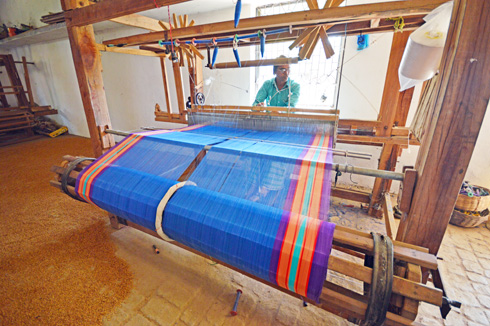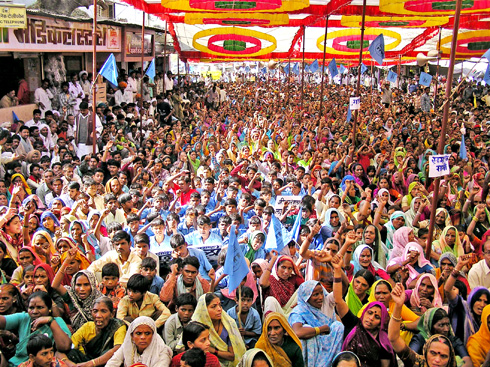We need faster growth, more investments, more reforms. This is the mantra being chanted by politicians and industrialists, economists and other experts, in an ever-increasing crescendo. We hear it at seminars and workshops, cabinet meetings, business award ceremonies, television and print media, and every other influential forum possible. Almost always, the justification given is that this is the only way to lift Indians out of poverty and deprivation. Interestingly, at none of these forums does one actually see the poor; images from a recent business newspaper’s award functions showed almost every one of the participants wearing crisp three-piece suits. All black, as if in mourning for the loss of a couple of percentage points of economic growth.
If the poor were at these forums, they might have asked some uncomfortable questions.
Why, for instance, are anything between 35 to 55% of India’s citizens still poor, and why does the government accept atrociously low survival criteria to determine poverty?
Can the Planning Commission’s Members live at Rs. 29 per day in Delhi, since they seem to think this is enough to pip the poverty line?
Why, despite 80% investment going into the formal economic sectors, has there been no net growth in employment in them?
Or why is India still stuck amongst the worst-performing countries on UNDP’s Human Development Index, or on the Global Hunger Index of the International Food Policy Research Institute?
Why, despite rip-roaring growth (amongst the fastest in the world), has Gujarat hardly moved in improving the condition of its children (44% were stunted in 1992, 42% in 2005-06)?
Why have upwards of 2 lakh farmers committed suicide, including many in the heart of the Green Revolution?
Why do 10% of rich Indians own over 50% of its wealth; is this where most of the new wealth generated by globalisation is siphoned off to?
Why, as Rural Development Minister Jairam Ramesh recently admitted, has the public health system collapsed, leading to over 70% of health expenditure being private, and forcing a huge chunk of the poor’s meager earnings to go towards paying doctors?
Can all this be due to inadequate reforms, or might it actually be because of the nature of these reforms?

Water harvesting near Bikaner supported by URMUL Setu. Pic: Ashish Kothari
Factor in the issue of ecological sustainability, and the doubts become louder. If the problems were not clear enough already, the recent Uttarakhand tragedy should have made them. Globally, the model of development is the same as in India; it has already degraded over 60 per cent of the ecosystems on which we all depend for our lives, and several of the planetary ecological limits we all are subject to, have been crossed. We are still altering the earth’s climate, with catastrophic results already unfolding.
A 2008 report by the Ecological Footprint Network co-published, interestingly enough, by the Confederation of Indian Industries, estimated that in India we were using twice the biological capacity that could sustain human activity, and we had already halved this capacity in the last few decades. The period of reforms has seen an acceleration of diversion of forest land (2 lakh hectares in just the last 5 years), mining operations, fishery exploitation, and damaging development along the coasts; for the first time in history, parts of the Indian Ocean are showing signs of depletion! We are already firmly on the path of unsustainability, rapidly reducing the chances of next generations to enjoy healthy, fulfilling lives. Not to mention the thousands of species of plants and animals, which are sliding towards oblivion. Even as the Ministry of Environment and Forests named the river dolphin the national aquatic animal a couple of years back, it was clearing dams and industries, effectively sealing its fate.

Handlooms promoted by Jharcraft, Jharkhand. Pic: Ashish Kothari
To add to the mismatch between statements regarding ‘sustainable development’ and actual actions, is the government’s latest decision to set up a Cabinet Subcommittee on Investment. Anyone willing to shell out Rs. 1000 crore is now getting priority treatment, including overruling of ministries (such as Environment and Forests, or Tribal Affairs) if they object to such investments. This is yet another way by which rational and democratic decision-making is being bypassed. Another way in which concerns will be bulldozed to allow construction in the most fragile areas, as was done in Uttarakhand’s chardham areas, with catastrophic results that we can all see now.
Today’s development model is one in which economic growth, which should be a means, has become an end in itself. A ritualized mantra intoned so often by our development high priests that the rest of us have even blindly started believing in it.
Resistance and Alternatives
Not everyone, though, has been hypnotized by the growth mantra. Across the country there are resistance and protest movements from adivasis and farmers, fisherfolk and the urban poor, unwilling to ‘sacrifice’ for a notional ‘national good’ that has only done them bad. They are facing repression and bullets, arrests and vilification (‘anti-national’ being a common label), but not backing down. Attempts to break them by bribing their leaders, or splitting communities with money, are succeeding in some places; in others they are being repulsed by collective action refusing to be lured by cash.
As farmers in Raigarh of Maharashtra told one of India’s most powerful businessmen, who wanted to acquire their area for a Special Economic Zone, ‘land is our mother, we won’t sell it; would you sell yours?’ Or as those to be displaced by the Jaitapur atomic power plant are saying, if you want to feed a power-guzzling Mumbai, build the plant on Malabar Hill or Chowpatty. No longer are many communities willing to be the ‘eggs’ that have to be broken to make an ‘omelette’ (to use a colourful phrase a Sardar Sarovar Project engineer once uttered to me, in justifying the project’s displacement of 100,000 people).
Equally important, there are growing voices showing that human well-being and happiness can be achieved in very different ways, more sustainable and equitable. If food security is a goal, Messrs Singh, Chidambaram and Ahluwalia would do well to look at how Dalit women farmers in 70 villages of Medak district (AP) have achieved it through collective governance of farm resources, organic cultivation of dozens of traditional varieties of millets, and creation of an alternative Public Distribution System fed by local produce.

Narmada demonstration (20th anniversary). Pic: Ashish Kothari
Villages and some urban wards in the driest parts of India, like Kachchh, have demonstrated how water security can be achieved through localized harvesting and sound management, putting a humungous question mark on the justification offered for mega dams like Sardar Sarovar. Communities in Bihar are showing how decentralised renewable sources can quickly provide energy security, not having to wait for unreliable power grid connections from super- polluting super-thermal power stations. So much so that Chief Minister Nitish Kumar wants to commit substantial funding to such sources.
What about non-agricultural livelihoods? Kuthambakkam Village in Tamil Nadu has workshops producing a range of products, as does Prakash Amte’s Anandwan, both providing dignified employment to the poorest and most socially ostracised sections such as Dalits. Producer cooperatives and companies are helping generate decent returns for craftspersons and farmers in Andhra Pradesh, Gujarat, and other states; some even manage their own retail. Communities in Vidarbha of Maharashtra whose right to protect and manage forests has been recognized under the Forest Rights Act are combining it with NREGS and other laws or schemes to make holistic development plans for their villages, and earning substantial revenues by sustainable use of bamboo, tendu, and other forest produce.
Slum dwellers in Bhuj are showing how localized water and housing projects can empower some of the poorest families, while dealing with typical urban problems. Citizens in many urban areas are showing how local water harvesting, garbage management, biodiversity spaces, and other initiatives can reduce the footprint of the city on the countryside, and provide more decent living to city-dwellers. And increasingly many of these initiatives are linking to scale up over larger landscapes or spread to other areas. With some governmental help, as in the case of Jharcraft in Jharkhand, the initiatives can reach lakhs of families.

Farmers of Deccan Development Society, Andhra in a biodiverse field. Pic: Ashish Kothari
Growth Fetish
Though there are far more sustainable and equitable options available to take all Indians towards prosperity, our decision-makers are stuck to the growth fetish. It’s a fetish that makes them blind to anything other than profits. This is why a company listed in London with an NRI as chair, which has been hounding the Dongria Kondh adivasis in Odisha to give up their sacred forested mountain for mining, is given ‘Businessman of the Year’ award. (As an aside, I wonder if he would have been awarded if he had instead pressed for demolition of the Somnath mandir or the Taj Mahal, because there was iron ore beneath it?). No awards for excelling in economic development are given to ‘ordinary’ citizens who demonstrate that livelihood security can be achieved without displacing people and destroying the environment.
It is also a fetish that produces strange schizophrenia. So a prominent businessman writes in the Times of India that we are a “land blighted by unemployment and sharp inequalities”; he then notes that his company’s “employee strength has been halved due to improved productivity” and outsourcing; and then he argues for more ‘reforms’ and growth completely oblivious to the ‘jobless’ nature of such growth as demonstrated by his own company.
Finally, it is a fetish that is brazenly undemocratic. This is why Telecom Minister Kapil Sibal can get away with blaming his government’s policy paralysis on some of the most important pillars of India’s democracy; at the aforesaid business newspaper’s awards ceremony, he is quoted as blaming “one, the erudition of the CAG; two, the media; and three, the court”. Such irresponsible pronouncements are fodder for state governments like Chhattisgarh who ride roughshod over basic civil liberties of people peacefully protesting forcible land acquisition. The government is even encouraging semi-autocratic governance in Special Economic Zones and private cities (e.g. Lavasa), where several democratic rights of citizens are suspended.
It is in this sense that the blind pursuit of growth is nothing short of violence on both the poor and on nature, and increasingly threatening even much of the middle class with pocket-breaking inflation and expensive private services. The sooner we as Indian citizens realize this, and press for fundamental changes to make social equity, ecological sustainability, and meaningful economic security the central pillars of decision-making, the sooner we will take the country towards true and lasting prosperity.
























